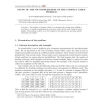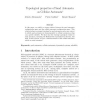126
Voted
JAC
2008
15 years 1 months ago
2008
Cellular automata are a simple model of parallel computation. Many people wonder about the computing power of such a model. Following an idea of S. Wolfram [16], M. Cook [3] has pr...
107
Voted
JAC
2008
15 years 1 months ago
2008
In this paper, two-dimensional cellular automata as one-dimensional language recognizers are considered. Following the approach of M. Delorme and J. Mazoyer to embed one-dimensiona...
89
Voted
JAC
2008
15 years 1 months ago
2008
Abstract. We consider simulations of graph automata. We introduce two local transformations on the neighborhood: splitting and merging. We explain how to use such transformations, ...
117
Voted
JAC
2008
15 years 1 months ago
2008
The problem of compact tables is to maximise the overlap when building a word that is to include permutations of every given words (all the words being the same length). This probl...
120
Voted
JAC
2008
15 years 1 months ago
2008
There are several systems consisting in an object that moves on the plane by following a given rule. It is frequently observed that these systems eventually fall into an unexplaine...
125
click to vote
JAC
2008
15 years 1 months ago
2008
In this paper, we exhibit a strong relation between the sand automata configuration space and the cellular automata configuration space. This relation induces a compact topology f...



